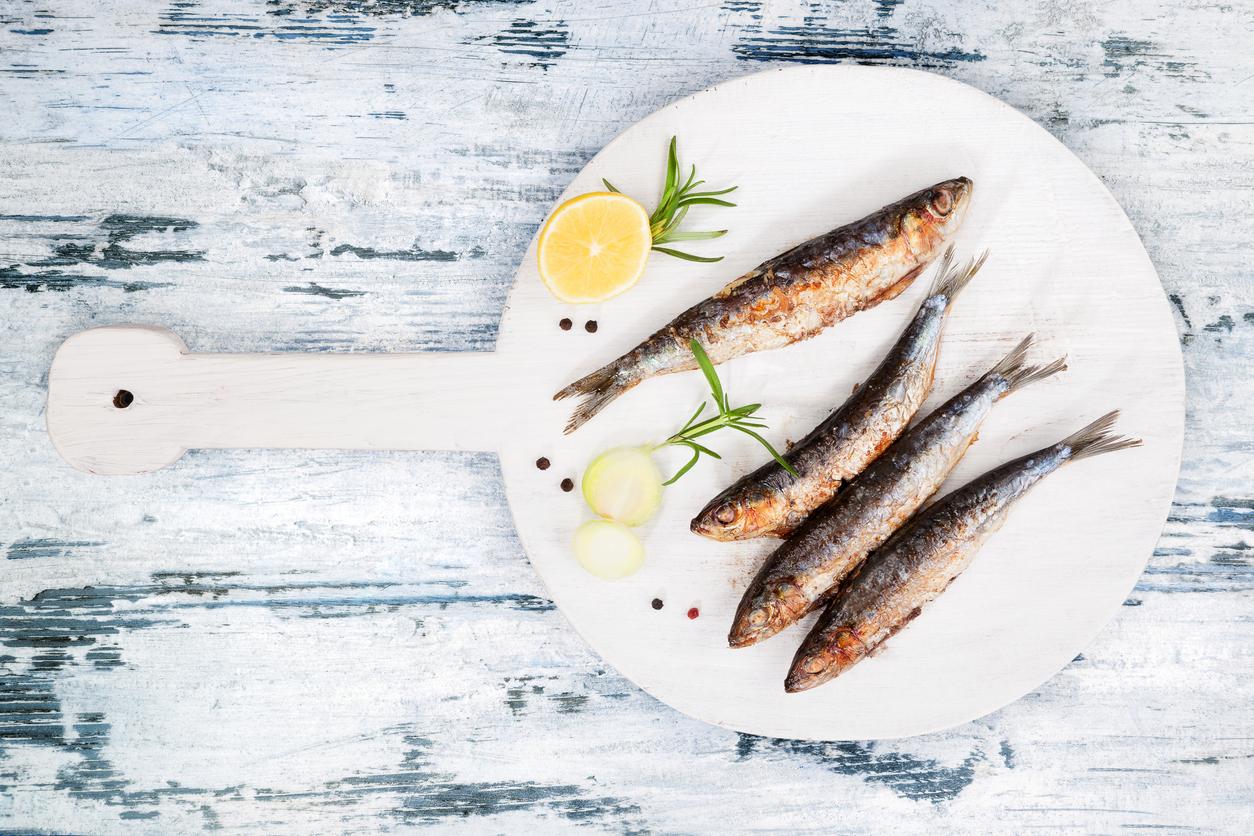Famous for their exceptional omega-3 content, fatty fish are not always well identified. Tuna, anchovies and trout, for example, are not oily fish but semi-oily… We have listed the oily fish for you to take advantage of their health benefits.
As part of a varied and balanced diet, it is recommended to eat fish at least twice a week, including one serving of oily fish.
Fish provide our body with essential nutrients. It is an excellent source of proteins, minerals (phosphorus), trace elements (iodine, zinc, copper, selenium and fluorine), vitamins (A, D, E and B12) and essential lipids, in particular Omega 3 in the specific case of fatty and semi-fatty fish.
The list of fatty and semi-fatty fish
It is important to consume them regularly because these polyunsaturated fatty acids are not produced naturally by our body.
Fish are classified according to their lipid content. We can distinguish lean fish also called white fish, semi-fatty fish and oily fish called blue fish.
Blue fish have a higher fat percentage than white fish. They contain between 8 and 15% fat, mainly polyunsaturated fats.
This is the reason why fatty fish are more filling than white fish. Also, the more fatty the fish, the more it contains polyunsaturated fatty acids, including the famous omega-3.
It should be noted, however, that the lipid level may differ depending on the cooking mode. Raw mackerel, for example, contains an average of 13.5% lipids. Baked, it has 15.8%, and smoked 24.3%!
As main fatty fish we can cite: mackerel, herring, sardines, salmon. Discover our top-10 fatty and semi-fatty fish.
The benefits of oily fish
Oily fish are appreciated for their rich in omega-3, essential fatty acids essential for the proper functioning of the body. They have a protective effect on our cardiovascular system and are necessary for the proper functioning of the retina, nervous system and brain.
We recommend them even more to pregnant women, because they intervene in the structure of all the cells of our body and in particular neurons. They contribute to the proper functioning of our brain and its development.
The Omega 3 also allow to reduce the ” bad cholesterol “(LDL) and promote the increase of” good cholesterol “. They protect against age-related macular degeneration (AMD) and would also have a positive effect on the regulation of mood, anxiety, prevention of Alzheimer’s disease and certain cancers. We have made a selection of the 10 best fatty fish for you.
1- Eel
With 18% fat, eel is the fattest (even more when smoked) of all fish and should be eaten with moderation in case of hypercholesterolemia or during a slimming diet.
Its richness in vitamin A, a powerful antioxidant and its composition in unsaturated fatty acids make it useful against cardiovascular diseases. It is particularly recommended for children, adolescents and pregnant women who are often deficient in iron, because it is very rich in it. It is always eaten cooked, poached, grilled or stewed.
2- Greenland halibut
Be careful because the halibut refers to two very different varieties of fish (and even more), Greenland halibut (17% fat) and Atlantic halibut which are lean fish (1.5% fat). Their lipid intake therefore has nothing to do with it.
It is the first (also called turbot) that interests us here because the other (called by contrast white halibut) is a slimming ally. It is low in calories with 110 calories per 100 g serving.
Greenland halibut is also called Greenland halibut. A lover of cold water (below 4 ° C), it has dark brown scales on the back and a lighter gray on the belly. With its sharp teeth, it hunts small prey such as shrimp. It can reach 1.30 m and weigh 45 kg with a lifespan of about 30 years.
Greenland halibut is a perfect combination of protein and fat in a 50/50 ratio. It is obviously very rich in omega-3, beneficial for cardiovascular health.
Halibut are resistant to cooking without undoing. But it keeps its virtues with rapid cooking at high temperature. It can be marinated for a few hours in a little citrus juice (lemon, orange, lime or grapefruit) with spices and / or fresh herbs of your choice. This wild fish is very popular because of its finesse and unique taste.
3- Herring
Herring is one of the most common fish in the North Atlantic, Blue in color on the back and silvery white on the belly, it is a pelagic fish, in other words it moves in numerous schools in the column of water.
With 11% lipids, herring is a particularly fish rich in unsaturated fatty acids, especially omega-3. Herring is also a good source of protein, phosphorus, selenium, group B vitamins (especially B2, B3, B5, B6 and B12), provitamin A, D, iron, zinc and copper.
These omega-3s also have anti-inflammatory effects, useful for treating conditions such as asthma, rheumatoid arthritis, psoriasis and inflammatory bowel disease. They would also help prevent mood disorders such as depression.

4- Mackerel
the mackerel common is a deep sea fish, with a streamlined body, appreciated for its flesh. Inhabiting most seas (Pacific, Atlantic, Mediterranean, etc.), it is a migratory fish that lives in cold water in summer before migrating to warmer waters in autumn.
Mackerel is a fatty fish (13.5% lipids) which has multiple health benefits. It is rich in protein, fat, B vitamins, vitamin D, vitamin E, selenium and iron.
100 grams of mackerel for example cover more than 700% of the recommended daily nutritional allowance of vitamin B12 for an adult; More than 70% of the recommended intake of vitamins B3 or PP; And more than 10% of the recommended intake of vitamin D.
5- Sardine
Like mackerel or herring, sardines represent one of the best sources of Omega-3 of animal origin: 2 small sardines (100 g) indeed contain 3.8 g of Omega-3 (especially EPA and DHA ).
The first industrial food, sardines in oil are considered a popular and fairly ordinary dish in France. This fatty fish (10% lipids), very rich in magnesium (467 mg / 100 g) has proven to be an excellent choice for muscle health, depression, and memory.
Sardine helps to regulate emotional balance, to protect the heart and the brain. It is a good source of vitamins and helps to keep the figure. Already cooked and ready to eat, it can be enjoyed simply on toast.
6- Salmon
the Salmon is a fish close to the trout, which lives in the temperate seas of the northern hemisphere. It has an elongated body with a bluish back and a wide mouth. Salmon is a carnivore that feeds on other fish. With 10% lipids, salmon is one of the oily fish. In itself, it is a good food, very digestible.
Apart from fatty acids and proteins, this fish also provides the body with a host of essential micronutrients (magnesium, calcium, zinc, iron, potassium, phosphorus, copper, selenium, vitamin B12, vitamin D, etc.).
Although transformed by his preperation, the smoked salmon remains digestible. But it contains more salt than the fresh. In addition, smoking creates a layer of aromatic particles that are potentially carcinogenic. Finally, it is more acidifying than fresh salmon. So don’t overdo it.
7- Tuna
Tuna is not a fatty fish but a semi-fatty one that can be found fresh or canned. Low in calories (150 kcal / 100 g), it is a great ally for our health. Consisting of 5.5 g of lipids on average, including omega-3s, tuna helps to prevent cardiovascular disease and some cancers.
Canned tuna is a source of protein and provides essential amino acids necessary for growth. It also contains vitamin PP which contributes to the proper functioning of the nervous system.
Finally, it is very rich in iron, as well as in magnesium, essential nutrients for the body, and is useful in case of deficiencies.
8- Anchovies
Anchovy is a small sea fish with a slender body and prominent upper jaw, which is usually eaten as an appetizer. It is a semi-fatty fish (6.5% fat) known for its protein content.
Low in calories, and ideal for slimming, anchovy contains good amounts of vitamin A good for the health of the eyes, provitamin A, vitamin D and vitamins of group B. Its flesh is rich in minerals and trace elements , especially iodine, phosphorus, potassium and iron. Its composition in vitamin E and selenium contribute to the health and beauty of the skin.
Often prepared in salt, canned anchovies must be rinsed under water before being incorporated into a preparation or oil. We can also use grilled, fried, in escabeche (garlic, onions and tomatoes) or as a seasoning for quiches, pies, pissaladières or meat sauces.
9- Swordfish
The swordfish is the only representative of the Xiphiidae family. This semi-fatty fish (6% lipids) evolves in tropical and temperate seas. It can measure more than 4 m in length and exceed 500 kg. It feeds on squid, crustaceans and fish, both day and night.
Like all fish, it brings proteins and minerals like phosphorus: 100 g of swordfish can cover more than 32% of the recommended daily allowance (RDI). It is also rich in mercury, iron and vitamins (B12, B6 and PP).
The Omega-3 and Omega-6 fatty acids contained in swordfish participate in particular in thebrain system balance, cardiovascular, hormonal and cellular.
We can taste raw or cooked swordfish, pan-fried, broken, poached or in the oven. It is also perfect for a fish skewer.
10- Trout
The trout is a very close cousin of salmon and there is no marked difference between the two. Smaller fish, which live in freshwater, are referred to as “trout”, and larger fish, which live in saltwater, are referred to as “salmon”. In fact, trout is less rich in fatty acids (6% lipids) than salmon.
Its consumption contributes to decrease cardiovascular disease risks, cases of depression and Alzheimer’s disease. Finally, other studies have observed a link between the consumption of fatty fish and a decrease in the incidence of arthritis.
We recommend to eat two or three meals of fish per week, alternating between fatty or semi-fatty fish and lean fish in order to benefit from their health benefits.
Do you know of other fatty fish? How do you prefer to consume them? Tell us in the comments.


















